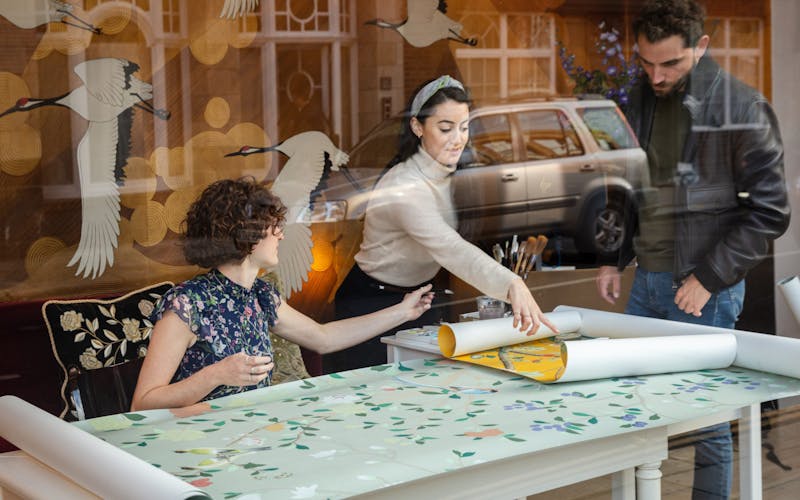

for Walpole members and
non-members available now
at The Londoner



I was chatting with Fabrizio Buonamassa Stigliani recently when I was struck by… well, just how Italian he is. Impeccably dressed, as you might expect from the Creative Director of watches at Bulgari, the famous Roman jeweller and watchmaker, and born in Naples, Buonamassa Stigliani is a fellow biker, so of course we ended up talking about motorcycles. ‘Ducati is the perfect expression of Italian beauty,’ he declared. ‘The mechanics are amazing, but aesthetics follow the mechanics.’
We were ostensibly discussing Bulgari and the house’s new watches, recently launched at the Watches and Wonders watch fair, and here it became clear that the aesthetics are also just as important as the mechanics. ‘Form follows function is not enough,’ says Buonamassa Stigliani. ‘That is closer to the Germanic ideal, to designers like Dieter Rams or Marcel Breuer. Italians have to have fun.
We have a saying – bello necessario – the necessity of beauty. If the watch – or any product – is not beautiful, it is not a success.’
He points out that in Italian there is not a word for design. ‘We talk about the art of industrial design. Art is too artistic, and engineering is too cold. So, instead of design we say arte applicata alla industria and combine the two. Now we have adopted the English word “design” – Italians love to play with English words – but for us this one word expresses a complex idea. For us it is about bello necessario – technical features that have to have beauty. There is also the estetica della macchina – the aesthetics of the machine – like a Ferrari engine, like a Bulgari extra-thin Octo Finissimo watch. The aesthetics are uncompromised.’
This conversation got me thinking. If the Italians have such a clear idea of the importance of aesthetics, and an equally clear idea of what their aesthetic is, in that it is about the celebration of beauty, then what is our equivalent? What do we, who have the word “design” in our vocabulary – a word, incidentally, that has seen increasing use and canonisation over the past few decades, arguably since the “designer” ‘80s – have as our characteristic national aesthetic?
How might we define British design?
I decided to ask a friend who I knew would have something interesting to say on the subject. Stephen Bayley, writer, broadcaster and critic was co-founder, with Sir Terence Conran, of the Design Museum and is frequently referred to as a “design guru”. If anyone could tell me what British design is, surely this was the man.
We started, ironically, with a socially distanced espresso in his garden, and being a self-confessed Italophile, when I tell him of my conversation with Buonamassa Stigliani he smiles and nods. ‘Well, the Italians have that unique expression: bella figura. It exists. It’s real. It’s not invented by copywriters; it has emerged from Italian culture,’ he says. Bella figura is something of a philosophy in Italy – the idea of cutting a fine figure. ‘Everything is aestheticised in Italy, from your morning coffee to your Ferrari Superfast.’ Indeed, he says, Luca Di Montezemolo, former Chairman of Ferrari, once told him that his cars were about massimo edonismo. We all have good enough Italian to know what that means. ‘The Italians have a real commitment to beauty,’ says Bayley. ‘To their countryside, their food, their arts.’
He tells the story of how he once asked the famous Italian architect Ettore Sottsass why Italy has got so many accomplished designers but so few design schools? ‘We’ve got a far more extensive art college system in Britain than they have in Italy, in fact more so than any country in the world. Sottsass said that you didn’t need colleges in Italy, as there an understanding of design is innate. We should remember that the workshops where up until not so long ago they used to build the bodies of Ferraris are where they’ve been bashing metals since the time of the Etruscans!’
But while the Italians are, he says, ‘famed for being enslaved to superficial beauty,’ our national characteristics in Britain are less easy to express concretely. ‘Here it’s about abstracts like good manners and empiricism and common sense. These don’t translate easily into tangible form.’
However, Bayley does believe that cultures express themselves through what they design and make. ‘Of course, relative to the past, we manufacture so little these days, but there is one way we can usefully look at the British design aesthetic, I think. As a nation we have really only made a modest contribution to the history of art, though we have excelled in literature, scientific research, theatre, parliamentary democracy and the communications business…
Our sole significant contribution to art and architecture, in my opinion, is the country house.’
Bayley’s contention is that when people think about British design, they are led back to the country house tradition. ‘Land Rovers, Range Rovers, Purdy shotguns, tweed, cashmere sweaters, brogues – it all stems from that aesthetic.’
And there is something peculiarly masculine about this, he feels. ‘Interestingly, Henri Racamier, who founded LVMH, held that French luxury is feminine while British is masculine: the French like dresses and champagne and the Brits, shotguns and tweed.’ His point is that we are tied in the imagination of the world to design in relation to our countryside and the great houses, gardens, architecture, paintings and entertainments that locate in this space.
Another characteristic that defines our design aesthetic, says Bayley, stems from our love of individualism. If in Italy there is a sense that the entire nation is on the same page when it comes to celebrating, appreciating, understanding and creating things of beauty, over here, the creative spark resides in a few exceptional geniuses.
In other words, it is a rare talent that produces great British design.
‘We believe in competitive individualism here. Maybe it has something to do with our love of sports – all the world’s major sports were created in this country. And though many are team sports, at root lies the prowess of the individual, the autonomous genius. We’ve talked about Ferrari, but over here we have created many motoring archetypes – Malcolm Sayer with the E-Type Jaguar, Alec Issigonis with the Mini, Charles Spencer King with the Range Rover. All idiosyncratic individuals.’
This means, says Bayley, that our most famous pieces of design come to fruition not through a process of aesthetic osmosis like you might find in Italy, but from a mix of personal ideas and circumstance. ‘Each of these cars was the product of the inspired individual rather than teamwork. No brainstorming created these; it was more a function of original ideas and good sense, which, incidentally, we might class as British characteristics, which I find inspiring.’
Bayley believes that the mythology of the remarkable individual, rather than the group effort, is something that has seeped into the British notion of luxury too. ‘One aspect that we as a nation might look for in a luxury product is that at some level it is the expression of a talented individual. That’s why a Lexus, even though a very fine machine, will never be thought of as a luxury product over here. There’s no Mr Lexus behind it. By contrast, though no one thinks Charles Rolls and Henry Royce are still alive, you do believe your Rolls-Royce is in part an expression of someone’s will.’
No one would argue that the E-Type, Mini, Range Rover and Rolls-Royce are anything but great design archetypes, but Bayley’s point is that they came about through a peculiar and relatively haphazard process. ‘They’re all a bit like another great piece of British design, the Spitfire, an inspired lash-up and make-do piece of engineering, not the result of research and development such as you might find in, say, Germany.’ Bayley argues that the Spitfire only made it into existence through the sheer willpower of another formidable individual, R J Mitchell, and that the Germans would not have designed the Spitfire. Indeed, they did not: ‘The Spitfire is wonderfully emblematic of British enterprise. Hand-made, expensive and difficult to make, it achieved performance characteristics that made it delightful to fly, but that significantly restricted the amount of armaments it could carry. Arguably the plug-ugly Messerschmitt, the German equivalent, might well have been a better warplane.’
But before we beat ourselves up over having created a beautiful aircraft with great character in place of a super-efficient fighter, this is nothing compared to the Italian version of the story.
‘In the late 1930s the Italians designed a war plane called the Breda Ba. 88 Lince, in many people’s estimation one of the most beautiful planes ever made,’ explains Bayley. ‘It was streamlined and broke speed records. But it was so complicated to build as they’d sacrificed so much to beauty, and significantly, as soon as they put the armaments on it, it literally could not take off. Now that philosophy, consciously making warplanes beautiful – who cares if it works or not? – is so Italian!’
Perhaps in the end though, the reason it is so hard to pin down what the British design aesthetic actually is, is because it is not in our character to shout about it. ‘You don’t wave the flag, you don’t talk about it, do you? It’s like that Walter Bagehot thing about not giving publicity to the monarchy – “We must not let daylight in upon the magic.” To talk about our aesthetic achievement somehow becomes un-British,’ says Bayley.
Stephen Bayley’s new book Value: What Money Can’t Buy: A Handbook for Practical Hedonism is out now, published by Constable in hardback, £18.99; bulgari.com
Peter Howarth is the founder of Show Media.






